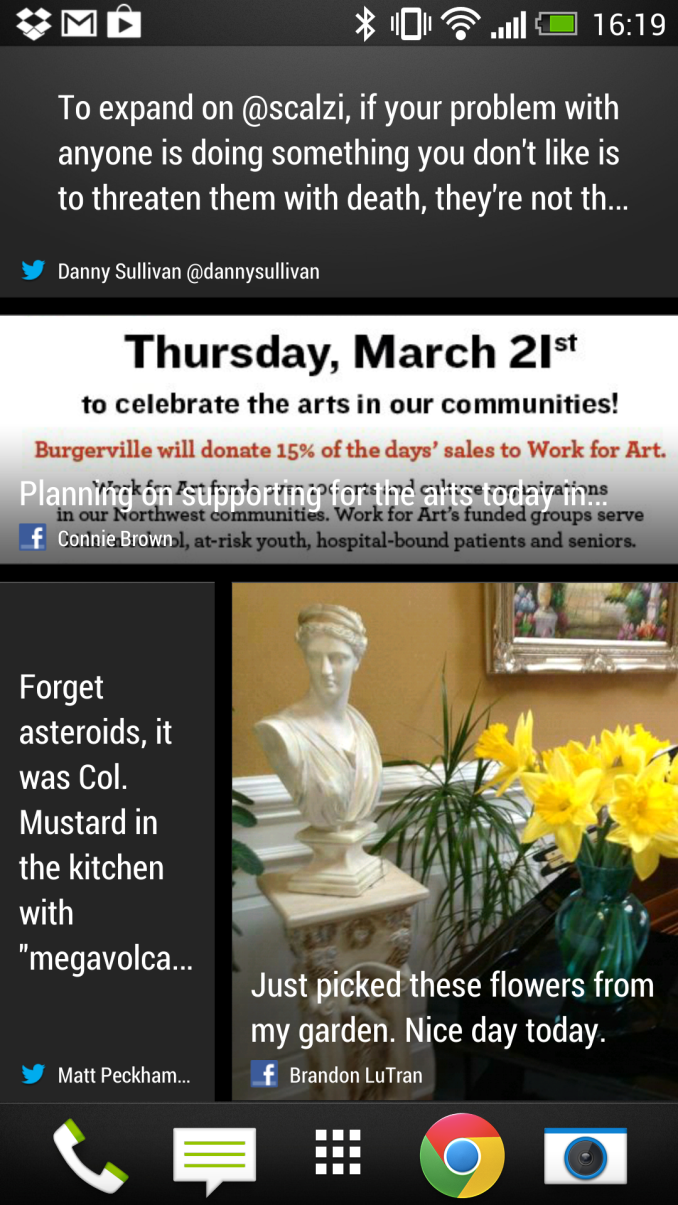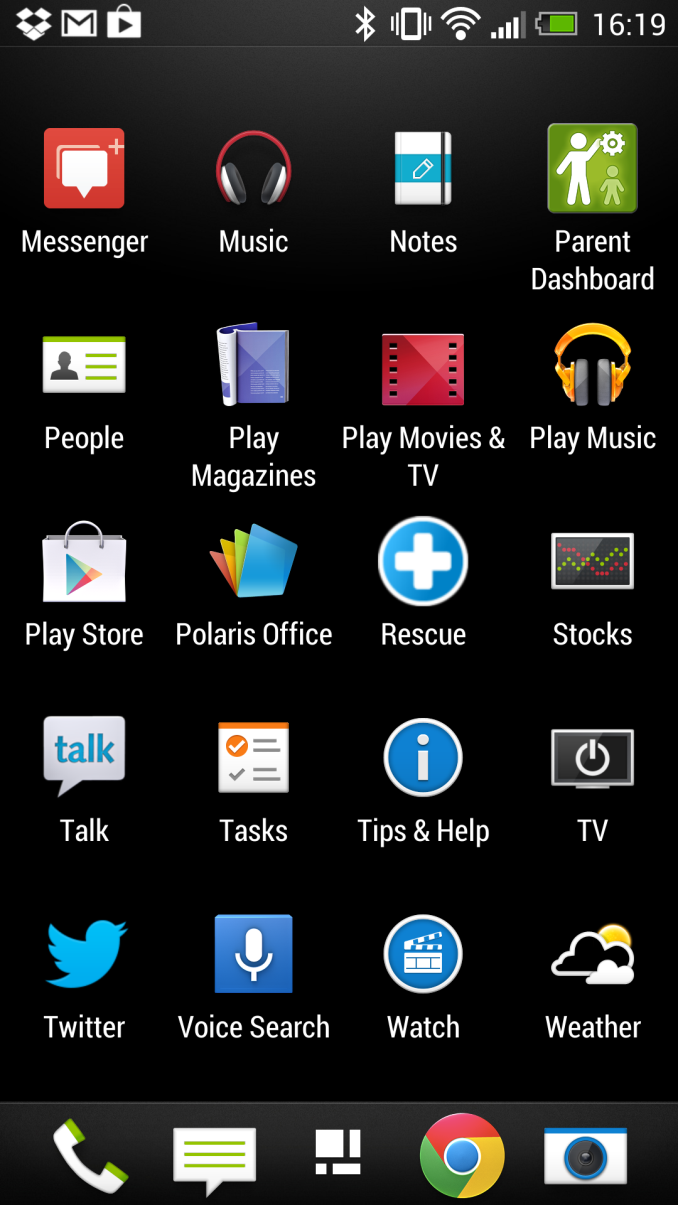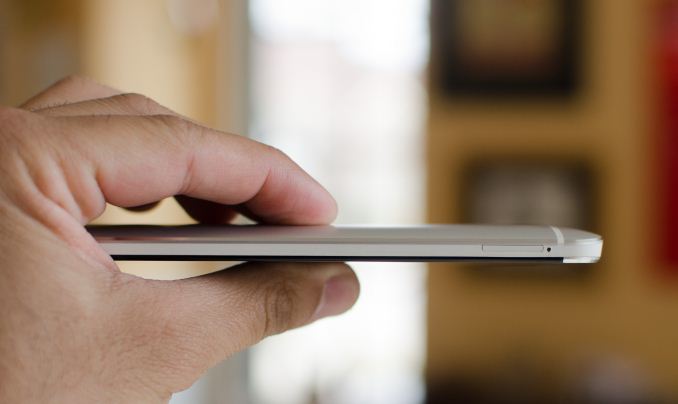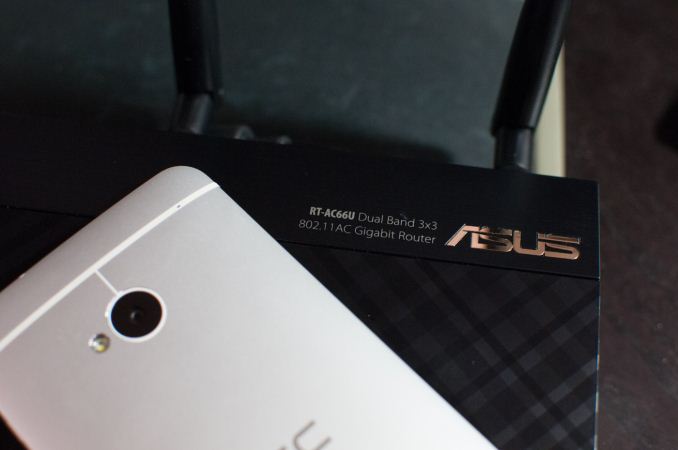The HTC One: A Remarkable Device, Anand’s mini Review
by Anand Lal Shimpi on March 21, 2013 4:49 PM EST- Posted in
- Smartphones
- HTC
- Mobile
- HTC One
Android/Sense
The One ships with Sense 5.0, and I have to say that the latest version of Sense is really the first custom Android skin that I don’t mind. I’m not sold on Blinkfeed, the default homescreen that allows you to aggregate content from multiple web sources as well as Twitter and Facebook, but thankfully you can easily change that default to something more traditionally Android.
With Sense 5.0 HTC dramatically reduced the presence of widgets on the default home screen. Other than the Blinkfeed screen, there’s only a single home screen by default and the only widget on that screen is a Google search box. You can obviously add all of the widgets you want, but this is a noticeable departure from HTC’s strategy in the past. To be honest, it’s a lot cleaner.
Sense 5.0 isn’t intrusive, and the work HTC has done in the gallery app sort of make the customizations worth it (more on this later). Even the default pre-load of apps is very sensible.
Thanks to the underlying use of Android 4.1.2 combined with the fast Snapdragon 600 SoC, UI frame rate is incredibly smooth. Some interactions are still not perfect (e.g. zooming in Google Maps) but the overall experience is very polished and very fast.
Performance & Battery Life
The One is the first Snapdragon 600 based smartphone that I’ve used regularly. For those who aren’t familiar with Qualcomm’s latest branding change, Snapdragon 600 refers to a quad-core Krait 300 based SoC with Adreno 320 graphics (APQ8064T). The SoC still uses the same 28nm LP process as the previous quad-core flagship (APQ8064), but clocks are a bit higher (1.7GHz in the One, 1.9GHz in the Galaxy S 4).
GPU clocks appear unchanged, which is contrary to what I was told at the launch of Krait 300 but it’s entirely possible that we’ll see implementation with higher GPU clocks.
Performance, as I mentioned before, is very good. Even the speed of the NAND HTC used in the device is among the best I’ve seen in Android devices. We’re still not yet at the point where I believe smartphone SoC performance is good enough, but at least we won’t see a huge jump in SoC performance (at similar power) until the move to 20nm in mid to late 2014.
The impact of all of this on battery life, as always, depends on your usage model. I’ve been using the international One on AT&T, and 3G battery life is comparable to the iPhone 5 on the same network (non-LTE) at identical brightness levels. I have yet to see what the difference will be like with LTE enabled.
Obviously with four cores and a larger, higher resolution display, the One definitely has the ability to draw more power than the iPhone 5. Keep the cores more active and/or drive the display at very high brightness levels and you’ll see worse battery life. For the past couple of years I’ve been talking about the increase in dynamic range when it comes to smartphone battery life, the One is no different in this regard. Brian will have a full rundown of battery life data on the One in his review.
Other Frills: Of Big Screens and Usability
For me, the iPhone 5’s display is a little too small, and the One is probably a little too big. I think I agree with Brian here in that the ideal display size is somewhere around 4.3”. That being said, I find both devices (the 5 and the One) to be comfortably usable. The 5 is better for one handed use, while the One is better for actually consuming web content. In pocket, the One is thin enough to not be a problem.
Although it’s probably a bit overkill, I am pleased with the move to 1080p across all of the high end Android smartphones. The One’s display looks excellent and lacks the oversaturated colors of the alternative AMOLED displays.
The One also features stereo speakers that get impressively loud (louder than any other smartphone I’ve used, by a considerable margin). I keep my phone on silent all the time but when showing others highlights reels, the One’s loud stereo speakers definitely come in handy.
The final element of the One that I’m really happy about is the integration of 802.11ac support. The One is good for WiFi speeds of up to 275Mbps (that’s actually tested, not theoretical).














434 Comments
View All Comments
DEECEE - Thursday, March 28, 2013 - link
Pentile AMOLED at 1080P on a 5 inch display is ONLY a problem in tech spec, not in actual user experience. I normally don't look at a phone screen through a microscope, and neither should you to care about Pentile AMOLED.Montago - Friday, March 29, 2013 - link
I've owned a Nokia Lumia 800 that has an AMOLED Pentile display -- its HORRIBLE !the resolution might have been the real problem (480x800 pix) - text was jagged and unreadable - some pictures looked good, others didn't ...
The problem is that you don't notice this problem when testing in the store, it gets anoying over time when you start noticing... i don't know if the SGS4 monitor has the same problems, but i bet they are there.
KoolAidMan1 - Thursday, March 21, 2013 - link
Samsung puts among the worst displays in their smartphones. What are you talking about?Forget about 440 PPI making the Pentile drawbacks irrelevant, their color calibration and contrast are terrible as well.
danbob999 - Thursday, March 21, 2013 - link
their contrasts are the best, given that blacks are perfect (no backlight)B3an - Thursday, March 21, 2013 - link
Well yeah, the blacks are vastly superior on Samsung's AMOLED (as you literally can't get any more black being as theres no backlight) but that's not the same thing as contrast balance. The contrast on my S3 and my S2 before it was pretty badly calibrated, and it varys a lot with each phone as my friend also has an S3 and the contrast is different (poor quality control). Contrast on the One X and iPhone 5 are better calibrated, and colours too. I'm sure it's the same with the One.But then with AMOLED you also get better pixel response times. So theres trade-offs for both LCD and AMOLED. If Samsung just fix the colour and contrast calibration then their displays definitely have the potential to be the best as the underlying OLED tech is superior to LCD in so many ways. I don't think the colours and contrast have anything to do with OLED itself, just that Samsung do not properly calibrate their displays.
BTW the S4 has uses a new diamond shaped pentile display layout, meaning the gaps between each sub pixel are much smaller (the larger gapes caused the fuzzyness/jaggies on the S3 display and others). Meaning the S4's pentile display will look better than the S3's pentile display even if it was still the same resolution. This combined with 1080p res should make it irrelevant if it's pentile or not as i doubt you'd be able to see the difference with human eyes.
robinthakur - Friday, March 22, 2013 - link
But that is what people said about the S3 when it first came out and I could see it immediately when I bought it. Coming from an iPhone the lack of quality display on the S3 is jarring. Text looks so much worse, it really ruins webpages and books.krumme - Friday, March 22, 2013 - link
There is certainly room for improvement here, as text imho is not sharp enough. But as explained earlier, that will probably be history now for s4. Besides, the brightness seems to have improved a good deal also. Thats perhaps more important for most people.CeriseCogburn - Monday, March 25, 2013 - link
The galaxy note 2 looks better than both of them.krumme - Friday, March 22, 2013 - link
As you have an S3, you might want to change the color profile to neutral. There is something besides the calibration and the black/white dynamics. There is dynamics of the individual colors, and thats what makes a lively picture and real world resemblance.You better get used to oled, because its comming to all high-end phones in the future.
piroroadkill - Friday, March 22, 2013 - link
Blacks can't be more black? Nope.I have a phone with a Super AMOLED 720p screen, and I'd wish for a good quality LCD in a heartbeat. My old Desire HD's screen has far, far better colour and appearance. Only the size and sharpness is better on my new one.
AMOLED degrades, horribly, leaving a tint.
Also, blacks aren't as black as you think. Turn on your AMOLED phone at night in a totally dark room, put a totally black screen up on it. It still has a faint grey glow, and infact, now you'll notice the horrible degradation of the screen - it manifests on mine as what look like "ink blots" only visible in very dark situations. Confirmed by many others around the internet.
Do not champion OLED. It's a technology leading us to planned obsolescence.